Understanding Moonstone Cost: Key Factors and Insights
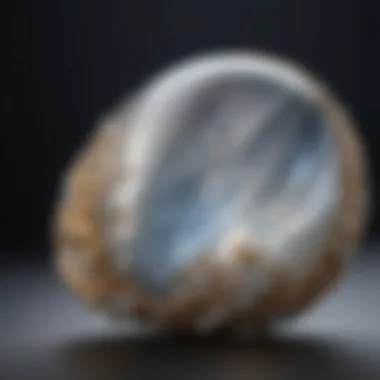
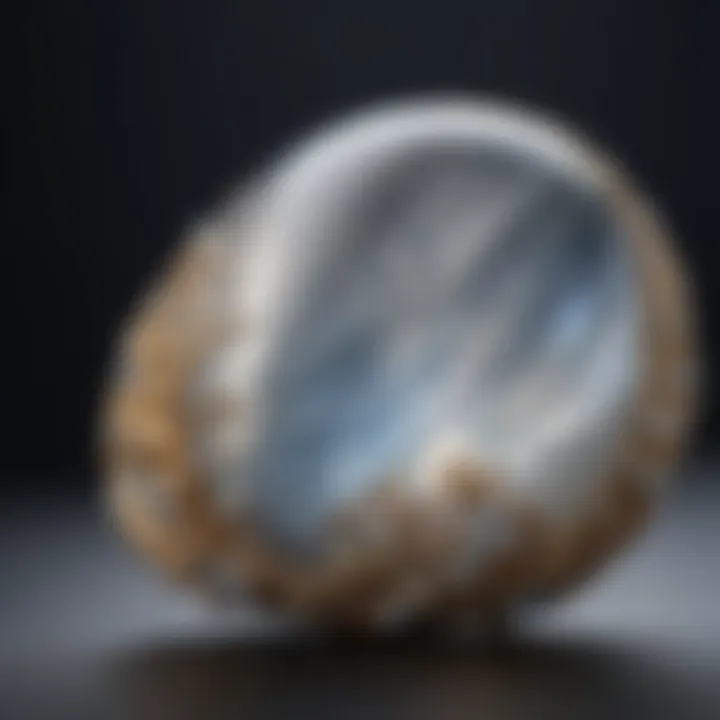
Intro
Moonstone, a captivating gemstone that has bewitched many for centuries, is not just another pretty rock. With its soft, shimmering glow and historical significance, it carries a weighty narrative that often eludes the average buyer. Understanding the various factors that contribute to its cost can be a bit of a rabbit hole, one that gemstone enthusiasts, collectors, and jewelry designers will find both enlightening and essential.
As we delve into this intricate world, we'll unpack everything from the definition and characteristics of moonstone to ethical sourcing concerns. The aim is to provide you with a toolkit for identifying quality moonstone while being culturally and ethically informed. You'll also gain insights into how the quality, origins, and market dynamics interplay to determine the price, allowing you to make educated decisions for your collection.
The purpose here is not only to arm you with facts and figures but also to foster a deeper appreciation for this gem’s rich tapestry woven with stories of its origins, its rolê throughout history, and its various uses in modern society. When you're buying moonstone, you're not just buying a piece of jewelry; you’re collecting a slice of nature’s artistry, imbued with meaning and history. Let's explore.
Prelude to Moonstone
Moonstone stands out not only for its aesthetic appeal but also for the deep cultural significance and historical richness it carries. In this article, the exploration of moonstone will span various aspects crucial to understanding its cost, with particular attention to its captivating properties and the myriad factors that impact its value.
Worthy of a spotlight, moonstone is often seen as not simply a gemstone but also a bearer of stories across civilizations, each adding layers to its allure. Appreciating its historical roots provides context for today’s market trends, shedding light on why certain pieces command a higher price. By comprehensively understanding these factors, enthusiasts, collectors, and jewelers can make more informed decisions, whether they’re looking to buy or simply wanting to deepen their knowledge of this enchanting stone.
Historical Overview
Winding back through history, moonstone has graced the realms of ancient cultures, being treasured for its supposed mystical properties. Civilizations like the Romans believed that this gem was formed from the rays of the moon, while in India, it was regarded as a sacred stone linked to the lunar goddess. During the height of the Art Nouveau period, moonstone captured the imagination of artists and jewelry designers alike, leading to a renewed interest in its ethereal glow.
Delving into the specifics, it’s interesting to note that the popularity of moonstone surged during specific eras. For instance, in the late 19th century, it became a must-have for European nobility and was often included in grand pieces as a symbol of purity and intuition.
Cultural Significance Across Civilizations
Throughout the ages, the cultural significance of moonstone has varied greatly from one civilization to another, reflecting an impressive tapestry of beliefs and values. In ancient cultures, it was esteemed as a protector and a guide. For Polynesian peoples, moonstone was thought to embody the spirit of the moon, carrying energies that fostered peace and harmony.
In the modern context, its use goes beyond mere adornment; it has made its way into spiritual and wellness communities, being embraced for its reported healing properties and calming presence. This gem serves as a bridge connecting generations of beliefs, clashing the past with the present in spectacular fashion.
"Moonstone is not just a stone; it's a sentiment tied to cultures and stories that resonate deeply across time."
To summarize, understanding the historical context and cultural significance of moonstone adds depth to its perceived value and can significantly influence the price tags that adorn exquisite pieces in today’s marketplace.
Physical Properties of Moonstone
The exploration of moonstone's physical properties is pivotal in comprehending its value and allure. This gemstone isn't just a pretty face. Its characteristics—such as color, clarity, and the intriguing play of light known as adularescence—play a critical role in determining both its aesthetic appeal and market price. Understanding these facets aids buyers in evaluating moonstone, ensuring they appreciate not just its beauty, but the science behind it as well.
Defining Characteristics
Moonstone comes in various hues, from silvery white to peachy tones and even deep blue shades. The most coveted varieties often exhibit a strong, distinct color with high clarity. For instance, an exquisite blue moonstone may fetch a significantly higher price than a more common gray variant.
Here are some of the defining characteristics that every enthusiast should pay attention to:
- Color: The most desirable colors are blue, white, and gray, with blue being the rarest and most expensive.
- Clarity: Though it may display inclusions, clarity contributes to the overall visual impact. Fewer inclusions generally lead to higher value.
- Size and Shape: Moonstone is often cut into cabochon shapes that amplify its natural beauty and adularescent phenomenon.
In essence, these characteristics form the foundation of moonstone’s identity, directly tying into its cost effectiveness.
The Phenomenon of Adularescence
One of moonstone's most enchanting attributes is adularescence, a term that describes the optical phenomenon whereby light appears to float just below the surface of the gemstone. This ethereal effect creates a mesmerizing glow, often shifting in intensity and hue based on the light's angle. The play of light is influenced by the gemstone's unique internal structure, primarily its feldspar composition, making it truly distinct among other gemstones.
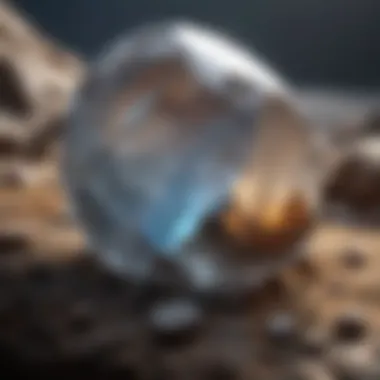
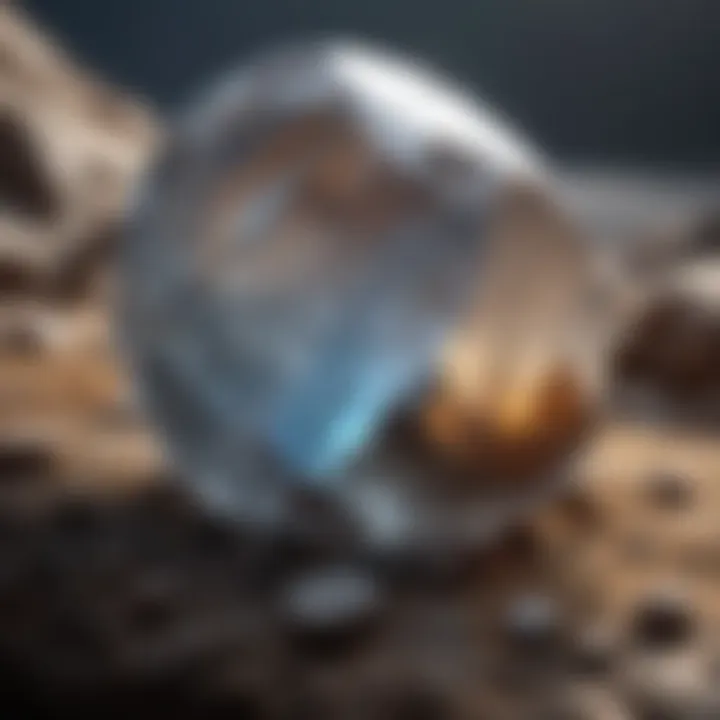
- Intensity: A strong adularescent effect typically enhances the stone’s appeal and price.
- Color: The color of the adularescent glow can vary, with blue and white light being the most prominent and sought-after in higher quality stones.
"Adularescence adds a layer of mystique and beauty, captivating the eye and the spirit alike."
In summary, understanding the physical properties of moonstone, especially its defining characteristics and the captivating phenomenon of adularescence, equips buyers with the knowledge needed to make well-informed decisions. The visible beauty coupled with the scientific wonders behind it transforms moonstone into more than just a gemstone. It becomes a cherished piece of nature's artwork.
Quality Factors Affecting Cost
Quality factors are like the building blocks of moonstone valuation, influencing how much collectors and enthusiasts are willing to pay for this intriguing gemstone. Understanding these elements not only aids potential buyers in making informed choices, but also provides insights into the overall market dynamics of moonstone. Key aspects include color, clarity, origin and rarity, as well as the precise nature of the cut and carat weight.
Color and Clarity
Color is arguably one of the most noticeable aspects when it comes to moonstone, affecting its visual appeal and ultimately its price. Various colors such as blue, peach, gray, and even colorless variations are available, but typically, a high-quality blue-gray moonstone with a sharp adularescence will command the highest price. The intensity of the color can heavily impact desirability.
Clarity also plays a significant role in determining quality. A flawless piece with minimal inclusions will certainly be more sought after than one with visible flaws. However, some enthusiasts appreciate inclusions for their uniqueness, which adds an intriguing twist to moonstone collecting.
"The beauty of moonstone lies not just in its surface charm but also in the depths of its clarity. An eye-catching piece can spark joy, transcending its material value."
Inclusion types can vary from tiny flecks to more substantial growth lines and, depending on the gemstone's overall appearance, they can be either a detriment or an accentuating feature.
Origin and Rarity
The origin of moonstone significantly contributes to its valuation. For instance, moonstones from specific locations, such as Sri Lanka or Myanmar, are often regarded as more desirable due to their long-standing reputations for quality. The accessibility of these sources affects the rarity; moonstones that are hard to find will naturally cost more.
Additionally, common varieties of moonstone might be widely available, but unique specimens—like those exhibiting strong color zoning or rare hues—will be valued higher. Factors like mining practices and geographical uniqueness influence the market. In essence, the more unique the moonstone is, the pricier it becomes, as collectors strive to own gems that stand apart.
Cut and Carat Weight
The cut of a moonstone affects its brilliance and how light behaves within the stone. A well-cut piece will enhance the adularescence effect, making the gemstone more visually captivating. Not all cuts are created equal; round, oval, and cabochon are among the most popular styles. The choice of cut can elevate the perceived value of the stone, aligning it better for jewelry settings.
Carat weight, on the other hand, is a straightforward aspect that usually correlates with cost. Larger stones are rarer and thus more expensive. However, while bigger may seem better, the quality of the cut and clarity must complement the size. A colossal moonstone that lacks clarity or is poorly cut may not fetch a high price, demonstrating that quality outshines mere size in this realm.
In summary, understanding these quality factors—color and clarity, origin and rarity, cut and carat weight—is essential for anyone looking to invest in moonstones. Take the time to assess these characteristics, as they are interwoven, forming the tapestry that is the true beauty and cost of each unique gem.
Market Trends in Moonstone Valuation
Understanding the current market trends in moonstone valuation is essential for both new buyers and seasoned collectors alike. The gemstone market can fluctuate based on various elements, and being aware of these can allow buyers to make smarter and more informed choices. Over the years, moonstone has grown immensely popular among jewelry designers, gemstone enthusiasts, and collectors who appreciate its subtle beauty and unique qualities. However, knowing the trends can give one a clearer picture of the valuation and worth of moonstone in today’s market.
As a collector or investor, it is crucial to consider factors like supply and demand shifts, seasonal trends, historical data, and emerging preferences in design or cutting styles. This knowledge enables individuals to navigate their purchases effectively and may affect overall resale value. Moreover, understanding these current trends can assist buyers in identifying authentic pieces versus those that may be overpriced or of low quality.
Current Price Ranges
Moonstone comes in various varieties, and its price range can vary significantly based on several determinants. Presently, the cost for moonstone can be generally grouped into a few categories:
- Low-End Moonstone: Prices for this category often range from $10 to $30 per carat. These stones are typically of lesser quality or may exhibit less striking adularescence.
- Mid-Range Moonstone: Stones in this category are commonly priced between $30 and $100 per carat. These often display good clarity and color without dramatic inclusions.
- High-End Moonstone: High-quality moonstones, especially those with exceptional adularescence or rare colors, can see prices ranging from $100 up to several hundred dollars per carat. For example, a well-cut rainbow moonstone might reach beyond the $200 mark, depending on the quality and aesthetics.
"Moonstone pricing is a reflection not only of its intrinsic qualities but also of market dynamics and consumer preferences."
Investment Potential
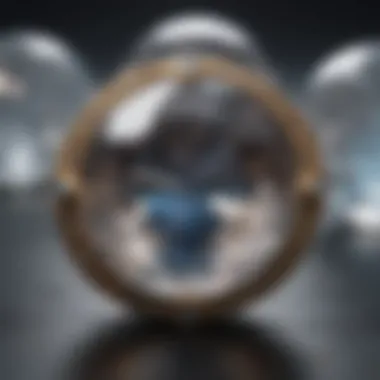
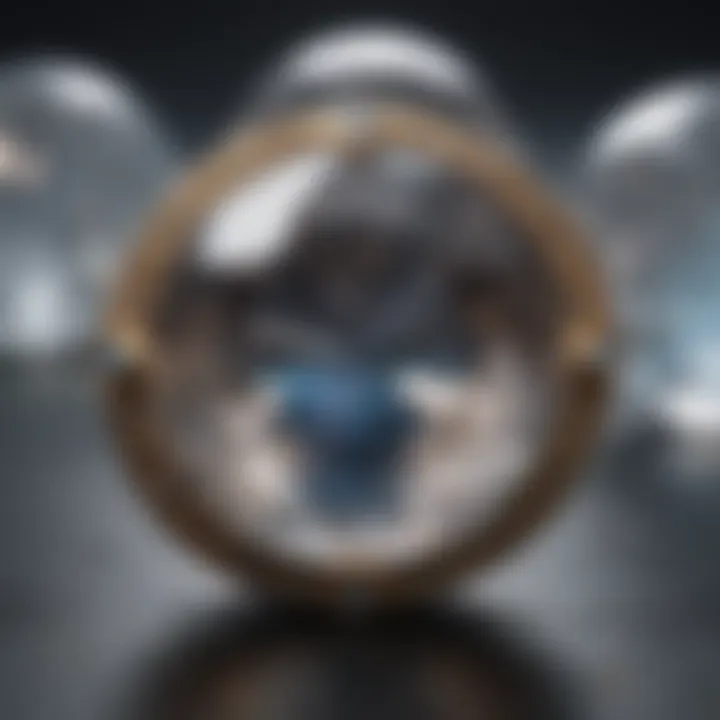
The investment potential of moonstone is an intriguing subject. While it may not have the mainstream recognition of diamonds or sapphires, moonstone has distinct characteristics that make it appealing for investors looking beyond traditional gemstones. Several considerations factor into its investment viability:
- Rarity: High-quality moonstones are not as frequently found as more conventional gemstones. Hence, certain types can appreciate in value over time due to their limited availability.
- Market Trends: Recent trends showcase a growing interest in unique and ethically sourced gemstones. This shift aligns with moonstone, given its ethereal beauty and metaphysical claims.
- Aesthetic Appeal: Moonstone’s ability to change appearance under varying light conditions creates a captivating allure that attracts both collectors and jewelry makers, adding to its desirability.
- Potential for Appreciation: Given the rise in demand for natural and ethically sourced gemstones, investing in high-quality moonstone can yield good returns, especially as new buyers enter the market and appreciate its uniqueness.
In summary, while the market trends indicate steady demand for moonstone and possible long-term value growth, any investment should be undertaken with caution, ensuring the buyer is well-informed about the characteristics and quality factors that influence its price. Recognizing these trends helps tailor a gemstone collection that is not only visually stunning but also potentially rewarding.
Ethical Sourcing of Moonstone
Ethical sourcing has become a cornerstone of consumer consideration, particularly in the gemstone industry, and moonstone is no exception. Global awareness about the ramifications of mining practices has grown, elevating the importance of sourcing moonstone in a way that respects both the environment and the communities involved. This section delves into why ethical sourcing matters, emphasizing its benefits and the essential considerations to keep in mind when purchasing moonstone.
Understanding Ethical Mining Practices
Starting with the basics, ethical mining practices revolve around methods that prioritize environmental stewardship and social responsibility. Unlike traditional mining operations that may leave behind a trail of destruction, responsible miners diligently follow guidelines that minimize ecological impact. This includes:
- Land Restoration: After extraction, the land should be restored, promoting biodiversity once again in the area.
- Fair Labor Practices: Workers deserve fair wages and safe working conditions, rather than being exploited in perilous environments.
- Community Engagement: Involving local communities in decision-making processes ensures that their needs and voices are heard.
By choosing moonstones sourced from adherent practices, buyers not only invest in a gemstone but also support a more ethical supply chain, which is vital for playing a part in global sustainability efforts. Each stone purchased carries a story, which reflects the values of the miner as well as those of the environment.
Impact of Sustainable Practices on Cost
Sustainable practices often come with a higher price tag, but the worth is evident in the long run. These practices lead to premium moonstone that's not just beautiful but also tells a tale of ethical responsibility. Buyers must consider:
- Initial Costs vs. Long-Term Value: Though sustainably sourced moonstones might cost more upfront, their value can appreciate over time due to increasing consumer demand for ethically sourced gems.
- Market Trends: Awareness and education regarding ethical sourcing are driving trends in consumer preferences. As more individuals seek to invest in responsibly sourced stones, this will likely affect price dynamics.
- Quality Assurance: Ethically sourced moonstones often come with certification or provenance documentation, guaranteeing that their journey aligns with modern values.
"Investing in ethically sourced gemstones not only enhances your collection but also supports a better world for future generations."
When weighing the cost of moonstones, prospective buyers should look beyond the initial price. The benefits of supporting ethical practices often ripple out, contributing to a more responsible and sustainable mining industry.
Understanding these facets of montstone sourcing can deepen the appreciation for this captivating gemstone, intertwining beauty with conscious consumerism.
Comparison with Other Gemstones
In the realm of gemstones, each type possesses its unique charm and characteristics that appeal to different audiences. Understanding how moonstone stacks up against other popular gemstones like opal and labradorite is essential for buyers looking to make smart investments. This comparison not only provides insight into the distinct features of moonstone but also highlights its market position amidst its counterparts. When collecting or designing jewelry, these comparisons can steer enthusiasts toward informed choices, enhancing their appreciation for the uniqueness of moonstone.
Moonstone vs. Opal
Both moonstone and opal offer that captivating play of colors, which often leads to confusion among buyers. However, the differences are quite significant, and knowing them can help in making a choice.
- Appearance:
- Durability:
- Value:
- Moonstone typically exhibits a gentle shimmer known as adularescence, with hues ranging from silvery whites to deeper blues. Its glow resembles the light of the moon, subtle yet enchanting.
- On the other hand, opal showcases a fiery display of colors, known as opalescence, shifting dramatically based on the angle of light. It's like a tiny world of colors trapped within.
- While both are somewhat sensitive, opal is generally more prone to scratching and breaking compared to moonstone. Therefore, those looking for a durable option may lean toward moonstone.
- Price-wise, opals can vary greatly, especially high-quality ones which command premium prices. Moonstone, while desirable, tends to be less expensive, making it a more accessible choice for buyers.
In summary, if one craves a striking display of colors and is ready for more careful handling, opal may be the gemstone of choice. But if the preference leans more to something understated yet alluring, moonstone shines bright.
Moonstone vs. Labradorite


Labradorite, with its incredible schiller effect, is another gemstone that often gets compared with moonstone. Here are some comparisons to consider:
- Visual Effects:
- Color Range:
- Cultural and Historical Significance:
- Like moonstone's adularescence, labradorite displays a remarkable color play known as labradorescence. However, labradorite often shows more vivid, almost metallic flashes in hues of blue, green, and gold, making it stand out more prominently in designs.
- Moonstone often sticks to more muted tones of blue, grey, or white, while labradorite dazzles with a broader spectrum. This can be important for jewelry designers who want to create eye-catching pieces.
- Moonstone carries a rich history tied to lunar deities and ancient civilizations, invoking a sense of spirituality and femininity. Labradorite, however, has its own lore centered around transformative qualities, often referred to as the "stone of transformation."
Practical Considerations for Buyers
When diving into the realm of moonstone, both seasoned collectors and newcomers alike should be well-versed in the practical considerations that come along with purchasing this unique gemstone. The nuances surrounding moonstone procurement are not just about the stone itself; they encapsulate broader themes such as ethicality, quality assurance, and market trends. Understanding these elements can ultimately empower buyers to act with confidence, ensuring their purchases are not only delightful but also responsible.
Where to Buy Quality Moonstone
Identifying reputable sources for purchasing moonstone is essential for obtaining high-quality specimens. Here are a few avenues to explore:
- Specialized Gemstone Dealers: Many experts and jewelers focus specifically on moonstone or gemstones similar to it. Building a relationship with such dealers can lead to better transactions. Their knowledge about the stones they sell is usually substantial.
- Gem Shows: Attending events like the Tucson Gem and Mineral Show provides a chance to see moonstone in varying qualities and cuts. One can often get direct feedback from miners or suppliers about the stones available.
- Online Marketplaces: Websites like Etsy or eBay can have good options, as long as one does due diligence on the seller. Look for reputable dealers with lots of positive feedback to minimize risk.
- Local Jewelers: Many jewelers offer a selection of moonstone jewelry. However, it's crucial to inquire about the quality and source of their stones directly.
Regardless of where one decides to purchase, verifying the authenticity and integrity of the dealer is paramount. The more informed and cautious you are, the less likely you are to fall into traps of subpar products.
Tips for Identifying Authentic Moonstone
When buying moonstone, one should aim to distinguish authentic stones from imitations. Here are several practical tips to enhance your identification skills:
- Check for Adularescence: A genuine moonstone exhibits a visible play of light, often described as a dreamy glow. Test the stone under different lighting conditions to observe this phenomenon.
- Look for Surface Features: Authentic moonstone may contain slight imperfections or inclusions. Too perfect of a stone might signal a synthetic product.
- Weight and Temperature: Moonstone typically has a heavier feel compared to glass alternatives, and it also retains colder temperatures than usual gemstones - a simple heft test can be revealing.
- Seek Certification: Whenever possible, request an appraisal or certification from recognized gemological laboratories. This can act as a safety net for buyers.
- Use a Jeweler’s Loupe: A magnifying tool can unveil minute details about the stone’s surface that can confirm whether it’s real or not.
"In the gemstone world, knowledge is your greatest ally. Equip yourself, and you can navigate the intriguing landscape of moonstone with ease."
By keeping these practical considerations in mind, potential buyers can confidently approach their moonstone adventures. Whether you are an expert collector or just now dipping your toes into the enchantment of moonstones, informed decisions will lead to more satisfying experiences.
Closure: The Lasting Allure of Moonstone
In the grand tapestry of gems and jewels, moonstone holds a unique and enchanting place. Its ethereal glow evokes not only beauty but also a rich history, cultural significance, and profound emotional connection. As we've explored throughout this article, understanding moonstone's cost encompasses many layers; it’s far more than just a price tag attached to a shiny stone. The interplay of quality factors, market dynamics, and ethical sourcing all contribute to its mystique.
When considering moonstone, appreciate that its value extends beyond the numerical. Collectors and enthusiasts often find themselves drawn to its metaphysical properties and the stories it embodies. Unlike some gems that are hoarded purely as investments, moonstone invites a deeper relationship. It speaks to those who seek not just an ornament, but a piece of nature's art.
"The true beauty of moonstone lies not solely in its shimmer, but in the sentiments it evokes and the memories it fosters."
Reflecting on Value Beyond Cost
In the world of gemstones, the concept of value intertwines closely with personal meaning. Moonstone, in particular, welcomes a subjective understanding of worth. While market appraisal can give a rough idea of its cost, the real treasure often lies in personal connection. Each piece may spark memories or symbolize significant moments in life. Jewelry designers know this well; people often seek moonstone for its romantic associations, like in engagement rings or gifts for milestones.
On a practical note, the valuation of moonstone considers its quality attributes—color, clarity, and cut—but these should be evaluated through a lens of personal taste. A piece that resonates with one individual may not appeal to another, making moonstone a deeply personal choice. So, when considering its cost, one must also weigh the emotional value it provides.
Encouraging Informed Collecting
For those embarking on the journey of moonstone collection, a methodical approach is essential. To ensure that your collection is not just another pile of stones, informed buying decisions should be the priority. Start by seeking reputable sources; this includes established gem dealers or jewelers known for their integrity and quality.
Additionally, understanding the basics of what makes moonstone unique can bolster your collecting strategy. Here are some pointers to guide your endeavors:
- Research before purchasing: Familiarize yourself with the various types of moonstone, including the rainbow, blue, and golden varieties—and their respective costs.
- Ask about certification: Ensure that your moonstone comes with proper documentation of its quality and origin. This may enhance its value and assure you of its authenticity.
- Join communities and forums: Engage with platforms like reddit.com or gemstone enthusiast groups on facebook.com to gain insights and share experiences with other collectors.
In the end, collecting moonstone should be an enjoyable journey marked by exploration and learning. By valuing each piece for the story it holds and the beauty it embodies, it transforms from mere prices to cherished treasures.



